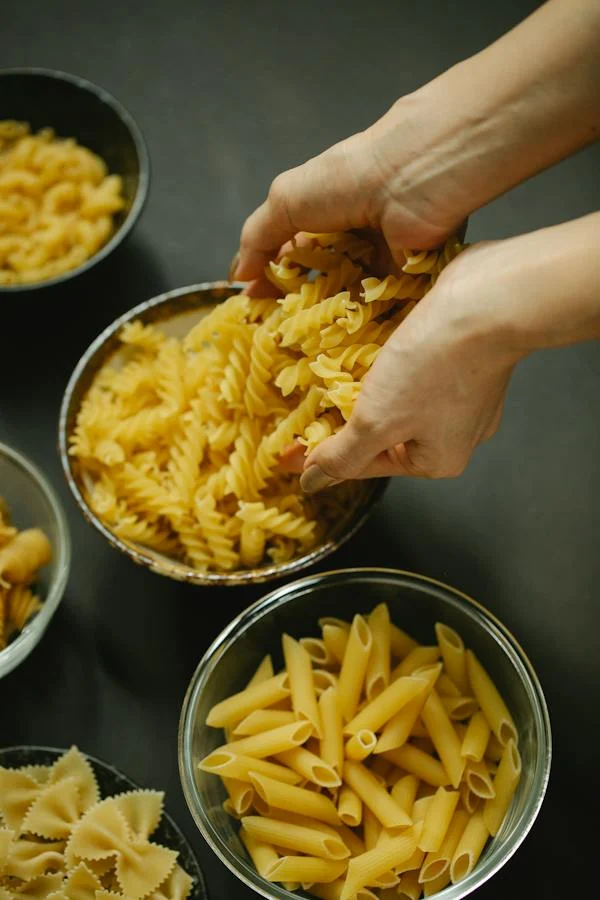In today’s post I answer the question- “Is protein pasta a good choice?”
When you look at grocery store shelves, protein is sort of the “it” nutrient among food producers right now. Protein powders. Protein bars. Protein breads. Protein Cheerios.
And now protein pasta.
Barilla Protein Plus Farfalle
I’ve been asked a lot about these protein pastas recently- especially since they are marketed directly to nervous parents as a nutritious solution for picky eaters. They seem to be a great fit, right? Pasta taste kids love? Check. Added protein to avoid the self-inflicted guilt about your child’s nutrition? Check.
Barilla Protein Plus Nutrition Facts Panel
But is it worth it? Let’s break it down…
Today I’m comparing regular ol’ whole wheat pasta to Barilla’s Protein Plus pasta. A single serving for either type is the same- about 1/4 cup dry (or 1/2 cup cooked). So all things being equal, how do they compare when it comes to protein?
- Whole wheat pasta- 8 grams protein
- Barilla Protein Plus pasta- 10 grams protein
So while you can see the Protein Plus pasta does have more protein, it’s probably not as much as you expect. And with the protein pasta coming in at nearly $2 a box, you’re paying nearly twice as much and only netting 2 grams more protein per serving.
Side note: If you took a good look at the front of the box, you might be asking, “why does the Protein Plus packaging say there’s 17 grams of protein per serving?” Check that asterisk- they are increasing the serving size from 2 oz. to 3.5 oz. (which is 350 calories of pasta). What if we increase our regular ol’ wheat pasta by that much? You’d come pretty close- 14 grams of protein.
17 grams? Only if you increase the average portion size…
Okay, so as you can see, the protein thing is totally not as good as it sounds. But if we take a closer look, Protein Plus pasta actually has a dark side.
Whole Wheat Pasta Nutrition Facts Panel
When I look at labels, I always look for fiber. Fiber is an important component of a healthy diet (which many Americans are short on). Furthermore, high fiber content is often the mark of a higher quality food (and one that will keep those kids fuller for longer). So how do these competitors stack up when it comes to grams of fiber per serving?
- Whole wheat pasta- 6 grams
- Barilla Protein Plus pasta- 4 grams?!
Wait, why did it go down? Isn’t Protein Plus pasta just whole wheat pasta with more protein added?
I mean, look at it- it’s brown!
Despite its appearance, Barilla Protein Plus pasta is actually enriched WHITE pasta- the sugar spiking, low nutrient stuff that’s kind of like a bad boyfriend (in that you shouldn’t really be bringing it home). How can you tell? There are a few clues but here’s one you can teach your kiddos: no 100% Whole Grain stamp on the box.
Simply put- Barilla’s actually removing the protein and fiber from it’s Protein Plus pasta and YOU are paying them to put it back in with something else (in this case, a flour blend derived from beans/grains).
Look mom! No stamp!
Verdict: Wham bam, feels like a scam.
Whole wheat pasta looking good with the 100% Whole Grain stamp.
But rest easy, moms. Protein is an abundant nutrient in many different types of foods (including regular ol’ whole wheat pasta) and protein deficiency is not common in places where there’s adequate food intake. If you want to bump up the protein in your pasta dinner, consider serving whole wheat pasta with a small side of lean protein, garbanzo beans, or my favorite, Quinoa & Kidney Bean “No- Meat” Balls.
And not all protein pastas are bad. For example, Banza Chickpea Pastas, Explore Asian brand pastas, and Dr. Fuhrman Tolerant brand pastas are all derived from high fiber/ high protein beans and legumes (like black beans, lentils, and edamame) rather than wheat- also an option if you’re going gluten-free.
Alternatives

